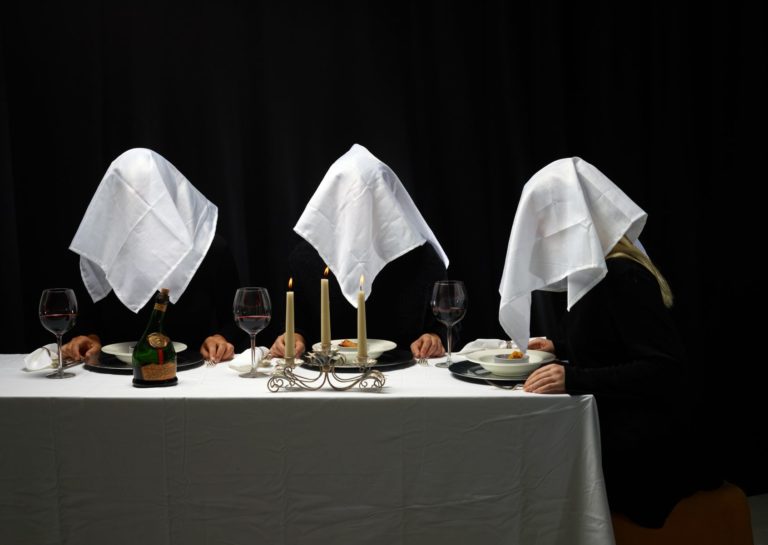SHE/HER/ME
an opera film installation in development
JEAN COCTEAU FILM & DIALOGUE
PHILIP GLASS MUSIC
JORINDE KEESMAAT CONCEPT & STAGING
MOLLY JOYCE NEW COMPOSITION
“Audience and performers are taken on a journey towards the light through a dark labyrinth, where projected images of Cocteau’s archetypal characters and the live performers come together to reflect on the here and now. What do I feel? What am I allowed to become? Who am I, in relation to you? Three dysfunctional love stories, all creations of the masculine heart and brain, all paralyzed.
Deconstructing Glass’ Cocteau trilogy and building a new piece with the reflective music of Molly Joyce helps me create a new “fluidity” in the husband/wife, brother/sister, possessor/possessed relationship. I’ll remix them, creating space for the female perspective.
The production re- examines how women define themselves not in relation to men, but as independent, autonomous beings. SHE/HER/ME is an opera-video labyrinth in which our search for self-expression begins.”
Jorinde Keesmaat, initiator and stage director
GLASS’ COCTEAU TRILOGY
Orphée, Les Enfants terribles and La Belle et la Bête are among the most fascinating cinematic works directed and/or written by the 20th-century French artist Jean Cocteau. Each film represents an ongoing search for the subconscious, which the artist is obsessively drawn towards and where reality is left for a dreamlike, magical and symbolic underworld. The “zone” which Orpheus wanders through in search of Eurydice and Death, “the Room” where Paul and Elisabeth play their secret “Game”, the castle of the Beast: in each of Cocteau’s films, a place is endowed with an alienating intensity in which fantasy, myth or dream become reality. Scenes are filled with objects that convey deeper meanings, such as the mirror: by confronting the self, the mirror functions as a gateway, a magical looking glass that Cocteau conjures up using liquid mercury and early experimental filmmaking techniques such as reverse motion and slow motion. In each film, a supernatural or otherworldly character enters the ordinary world of the protagonist. It is the muse, death, the subconsciousness of the poet himself, luring the artist into another realm.
When American composer Philip Glass set Cocteau’s films to music, he experimented with the possible relationships of opera to film. For every film, he took a different approach, setting the entire libretto to music (Orphée), introducing dance (Les Enfants terribles) or, in its most radical treatment, replacing Cocteau’s entire film with new instrumental and vocal music, painstakingly synching every spoken syllable (La Belle et la Bête). By doing this, Glass explored new ways of conceiving a live ‘film opera’. Glass’s distinctive composition style makes the underlying tension in Cocteau’s works palpable to such an extent that it at times evokes a hypnotizing and even unsettling experience.
SHE/HER/ME is a newly developed opera-film installation around the works Orphée, Les Enfants Terribles and La Belle et la Bête by American composer Philip Glass and French artist and filmmaker Jean Cocteau. Dutch stage director Jorinde Keesmaat presents a rework of the trilogy by confronting the power of the cinematic images to the power of the music, focusing on the three couples: Orpheus and Eurydice, Paul and Elisabeth, The Beauty and the Beast.
In his films, Cocteau is constantly searching for his inner self through his characters, by confronting them and making them explore their subconscious, from where an artistic and sensual, erotic voice responds. SHE/HER/ME revisits the search for the self from a female perspective. To find the inner beast, beyond the limitations of norms and assigned gender.
Three couples try to break free from their confined identities. What do I feel? Who am I, in relation to you? Who am I allowed to become? Engulfed by the surrealist images of Cocteau’s films, the hypnotising pulse of Glass’ music, and guided by an enigmatic figure — the subconscious, the omniscient, the angel,… —, both audience and performers are sucked into an inward journey.
Emerging composer and performance artist Molly Joyce – deemed one of the “most versatile, prolific and intriguing composers” of her generation – is invited to create a new musical world that challenges Cocteau’s fictions and Glass’s music. A new musical world in which the unsuspected, invisible or underlined strengths and reservations of the characters can fulfil the narratives.
Today’s reading of Cocteau reveals the complexities of gender and power relationships in his work. Cocteau’s fascination with the interplay of identity and power structures presents opportunities to critique patriarchal and “traditional” gender dynamics. To amplify women’s voices and experiences within the symbolic roles assigned to Eurydice (Orphée), Elisabeth (Les Enfants Terribles), and La Belle (La Belle et la Bête), Molly Joyce will build her vocal music on a series of selected poems and texts
to represent the female perspective and give space to the unheard voices. This way, internationally celebrated poetesses and feminist writers from the 20th and 21st centuries shall mark out our journey, step by step, building a bridge from Cocteau’s era to our own. The collage intends to include figures from both the avant-garde of Western feminism and pop culture such as World War I poet Hilda Doolittle, best-selling author Margaret Atwood, political and lesbian icon Adrienne Rich, Radical Feminism writer Susan Sherman, Polish Nobel Prize winner Wislawa Szymborska or prominent singer and writer Patti Smith. Such a collection of texts will allow the production to explore the limitations, ambiguities, and subversive power of the original narratives.

